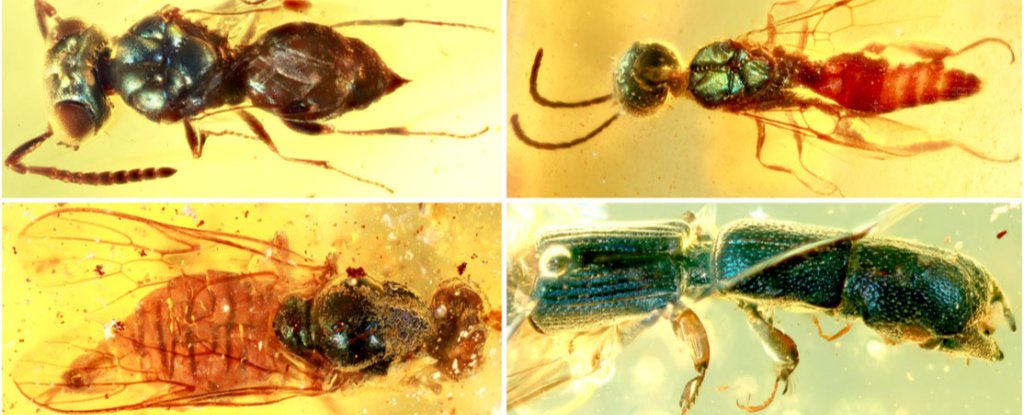
When you think about the color scheme that the prehistoric world of dinosaurs looks like, greens and browns usually come to mind.
But more and more research has shown that millions of years ago, vibrant, vibrant colors were everywhere in nature, just as they are today. The latest evidence: 99-million-year-old insects trapped in amber with amazing colors of purple, blue, and metallic green.
One of the reasons why we find it so difficult to know the colors of prehistoric creatures is because of what remains of them: a fossilized bone cannot transmit what color the animal was. But lately, scientists have been working on fossilized feather pigments; Or, in the case of this latest study, he used Burmese amber to look into the world of ancient colors.
“The type of color preserved in amber fossils is called structural color. It is caused by the microscopic structure of the animal’s surface,” said paleontologist Pan Yanhong of the Chinese Academy of Sciences.
“The surface nanostructure scatters light of specific wavelengths and produces very intense colors. This mechanism is responsible for many of the colors we know from our daily lives.”
 A series of insects studied by the researchers. (Cai et al., PRSB, 2020)
A series of insects studied by the researchers. (Cai et al., PRSB, 2020)
Structural color is what makes peacock feathers and butterfly scales appear iridescent; in this case, it was created by the external cuticle of the insect’s exoskeleton.
The team collected 35 amber specimens containing ancient insects that also possessed these intense structural colors.
The vast majority of specimens were cuckoo wasps (family Chrysididae) or warm wasps (part of the Chalcidoidea superfamily). The amber-covered creatures showed their metallic bodies in teal, yellowish green, purple blue, or even vibrant green.
Interestingly, the cuckoo wasps in amber (see, for example, the first green insect in the series of images above) were almost the same color as cuckoo wasps today.
 A modern cuckoo wasp. (Wasrts / Wikimedia / CC BY 4.0)
A modern cuckoo wasp. (Wasrts / Wikimedia / CC BY 4.0)
“The color that fossils show can often be misleading because the fine nanostructures responsible for coloration can be altered during fossilization. However, the original color of fossils can be reconstructed using theoretical models,” the team writes in their article.
“The calculated reflectance peaks coincide with the observed metallic bluish-green coloration of the mesopleuron of our studied wasp, confirming that extremely fine nanostructures can be preserved in mesozoic amber.”
The team also believes they have an explanation for why only some amber insect fossils retain the coloration of the animals indoors.
After cutting the exoskeleton of two of the vibrating wasps and a relatively opaque fossil, they discovered that in the opaque sample, the cuticular structures that create the structural colors are damaged. In the colorful fossils, insect exoskeletons and light-scattering nanostructures are still preserved.
While we admire the discoveries, it is important to note that the paleontology community is debating whether the scientific information that can be obtained from these specimens collected and sold in Myanmar is worth the price of possible human consequences, including persecution of ethnic minorities .
In recent years, amber has given us incredible creatures from the Cretaceous. These animals lived almost 100 million years ago, and the findings include the skull of the smallest dinosaur, some tiny frogs, a bird with an oddly long finger, and many, many more.
The research has been published in Proceedings of the Royal Society B: Biological Sciences.
.